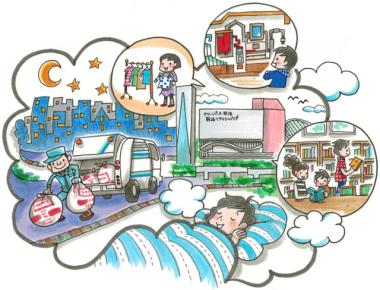Hakata Culture vol.76
The Fukuoka Method: Advanced Waste Treatment

Sometimes things that seem commonplace to those of us who live in Fukuoka are considered remarkable in other parts of Japan. One example of this is the City's trash collection system. Fukuoka's nighttime trash collections are unusual in Japan; we are the only designated city that does this. Daytime collections can lead to traffic jams and crows scattering and eating trash, but these problems can be avoided by collecting trash at night.
Trash collection began in Fukuoka City in the Meiji Era. Back then, household trash was used by farmers as fertilizer and animal feed. Trash collection was a part-time job done by people such as farmers who had other jobs. For this reason, the trash collectors made their rounds in the early morning when it would not conflict with their regular work schedule. This is the precursor to the City's current nighttime collections. With the spread of the automobile, the City began collecting trash at night, when there was not much traffic, in the 1950s.
The City also employs a semi-aerobic landfill design for non-burnable trash, and this is commonly referred to as the "Fukuoka Method". The Fukuoka Method was jointly developed by Fukuoka City and Fukuoka University in the 1970s and is now used in landfills around Japan. This landfill method not only reduces hazardous substances such as carbon dioxide and methane gas, it is cheap to build and maintain. It is now widely used in developing countries and other areas around the world. In 2011, the Fukuoka Method was designated by the United Nations as an effective technique for mitigating global warming.
If you are interested in learning more about Fukuoka's waste treatment and recycling methods, we recommend you visit the Rinkai 3R Station located on Hakozaki Wharf in Higashi Ward. Rinkai 3R Station offers courses on recycling and holds various events, and you can tour the incineration plant located next door. There is also a sports park on site, so feel free to bring your family.
先駆的な福岡方式のゴミ処理
福岡に住んでいると当たり前のことが、全国的には珍しいケースがあります。福岡市のゴミ収集システムもそのひとつ。福岡市では夜間にゴミの収集作業が行われていますが、これは全国でも珍しく、政令指定都市では福岡市だけです。昼間に収集作業を行うと、カラスなどによる食い散らかしや、収集作業による交通渋滞を招いてしまうことがあります。夜間であればこうした心配もありません。
福岡市のゴミ収集制度は明治期から始まり、ゴミは農家の肥料や家畜の飼料にされていました。この当時、収集作業を請け負っていたのは農家など他に仕事を持つ兼業者でした。そのため本業に差し支えのない早朝に収集作業を行っていたそうです。これが現在の夜間収集の前身となります。その後、自動車の普及とともに、昭和30年代から交通量の少ない深夜に作業をするようになりました。
また不燃ゴミの埋立についても、一般に「福岡方式」として知られる「準好気性埋立構造」が採用されています。1970年代前半に福岡市と福岡大学が共同開発したもので、現在では日本各地の埋立場でも採用されています。この方式は二酸化炭素やメタンガスなどの有害物質を減らすことができ、建設費や維持費も安いことから、新興国をはじめとした世界各国にも普及しています。2011年には地球温暖化を抑制する方法として、国連からも認定を受けています。
福岡市のゴミ処理やリサイクルについて学びたい場合は、東区箱崎ふ頭にある「臨海3Rステーション」がおすすめです。実際にリサイクル活動に参加できる講座やイベントが開催され、隣接する焼却工場の見学もできます。運動公園も備えているので、家族で気軽に出かけてみてください。

